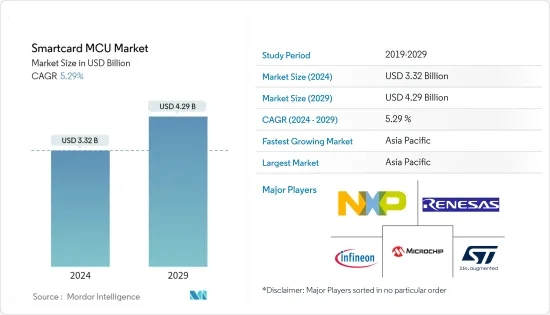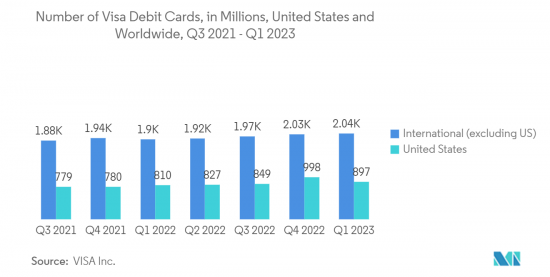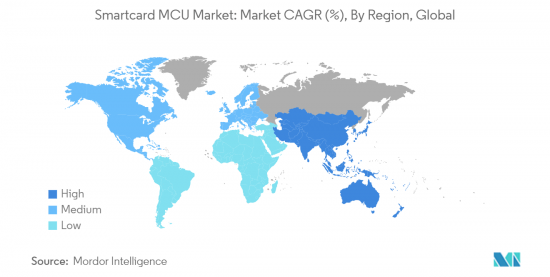 |
市場調查報告書
商品編碼
1430499
智慧卡 MCU:市場佔有率分析、產業趨勢與統計、成長預測(2024-2029 年)Smartcard MCU - Market Share Analysis, Industry Trends & Statistics, Growth Forecasts (2024 - 2029) |
||||||
※ 本網頁內容可能與最新版本有所差異。詳細情況請與我們聯繫。
智慧卡MCU市場規模預計到2024年為33.2億美元,預計到2029年將達到42.9億美元,在預測期內(2024-2029年)複合年成長率為5.29%。

主要亮點
- 隨著網際網路的迅速擴展,電子商務在電腦使用者中即使不是一種習慣,也已經成為現實。然而,目前電子商務應用中使用的經營模式並不能充分發揮電子媒體的潛力。
- 市場成長是由RFID技術和智慧卡NFC市場開拓的進步所推動的。利用無線射頻識別 (RFID) 技術快速發展的接觸型智慧卡越來越受歡迎。這些卡片使用 RFID 技術來處理交易。由於消費者需求不斷成長,主要供應商正在專注於推出接觸型智慧卡,預計這將推動市場成長。
- 智慧卡技術在交通運輸產業的普及正在推動市場普及,同時政府對數位科技採用的投資也不斷增加。電子智慧付款卡現在是交通運輸業者可行的替代付款方式。近年來,許多營運商和系統供應商都推出了基於智慧卡的系統來補充或取代現有的付款方式。
- 此外,安全性和小型化是IC卡技術發展最快的兩個方向。隨著世界轉向更安全的 EMV銀行業務卡,最新一代智慧卡擁有完整的片上加密功能,顯著提高了整個產業的卡片安全性。此外,智慧卡正在被小型化為各種外形尺寸,例如迷你標籤和智慧型穿戴裝置。隨著智慧卡與電話和生物識別技術一起擴大被採用作為二因素憑證,這種趨勢可能會持續下去。
- 智慧卡面臨的主要挑戰是其安全等級。為了充分發揮其潛力,智慧卡必須與各種介面進行互動。然而,出現了有關公眾認知的安全問題。人們可能需要意識到儲存在卡上的個人資訊是安全的。然而,必須認知到,從 IC 卡中提取的資訊是在其他地方收集和分析的。
- 此外,在各國政府和世界衛生組織的倡導下,COVID-19 大流行加速了接觸型智慧卡的採用,以防止冠狀病毒的傳播。由於患者數量的增加和醫療保健的數位化,醫療保健智慧卡在大流行期間和之後變得普及。
智慧卡MCU市場趨勢
BFSI 推動成長
- 銀行和金融機構的智慧卡包含專用的積體電路卡,以確保強大的安全措施。這些卡具有內建記憶體晶片和微處理器,可實現安全的資料儲存和處理。這些卡片在金融活動中執行多種功能,包括交易授權、安全存取網路銀行業務服務、簽帳金融卡和信用卡付款以及非接觸式支付方式。
- 付款流程的數位化很大程度上歸功於網際網路的發展和電子商務的出現。這種轉變催生了廣泛的電子付款選項,從付款卡(信用卡和金融卡)到數位錢包、電子現金和非接觸式付款方式。行動付款服務日益普及,目前正處於轉型期,並為未來的技術進步做好了準備。此類付款方式的進步預計將利用智慧卡技術並推動市場成長。
- 配備 MCU(微控制器單元)的智慧卡通常與個人識別碼 (PIN) 一起使用。 MCU 有多種用途,包括增強組織的安全性、充當多重身份驗證 (MFA) 令牌以及對單一登入 (SSO) 使用者進行身份驗證。線上交易的指數級成長已經超過了面對面交易,這在一定程度上要歸功於疫情大流行以及 Apple Pay、Klarna、Stripe 和 Amazon Pay 等替代付款方式的興起。這些進步大大擴展了智慧卡技術在產業中的潛在應用。
- EMV 卡技術採用整合到信用卡和簽帳金融卡中的小型、強大的晶片,並被認為是一種不斷發展的付款解決方案。 EMV 代表 Europay、Mastercard 和 Visa,代表了該行業標準背後的共同努力。這些先進的卡片對於透過減少信用卡詐欺造成的損失、促進更安全的付款環境並確保更安全的交易體驗來加強業務和客戶安全至關重要。
- 大多數新型 EMV 卡和基於晶片的讀卡器都配備了近場通訊(NFC) 技術,可實現非接觸式付款。客戶可以在讀卡機上刷卡,以實現更快、更安全的交易。除了增強安全性之外,EMV 智慧卡還透過安全的卡到終端通訊提高了速度和便利性,使商家和持卡人都受益。
- EMV卡配備了採用加密演算法的晶片,每次使用時都會對資料進行唯一的加密,使交易更加安全。對於持卡交易,這些卡片採用雙重身分驗證流程,需要實體卡片和客戶的密碼。這種身份驗證方法可驗證持卡人的身份,並對晶片產生的動態密碼(OTP) 進行驗證和核准。預期的技術進步將推動對智慧卡技術的廣泛需求,並在短期內推動市場成長。

亞太地區預計將佔據主要市場佔有率
- 亞太地區智慧卡技術的採用正在經歷向多應用程式智慧卡的轉變。這些卡片具有多種用途,包括付款、識別和存取控制,為消費者提高便利性和效率,並降低企業成本。此外,對改進智慧卡安全功能的需求日益成長,特別是隨著線上交易的增加。
- 智慧卡技術在印度廣泛普及,部分歸功於政府對數位化的關注。幾乎每個印度公民都可能擁有某種形式的智慧卡。這些卡片廣泛應用於各個領域,包括銀行、醫療保健、交通和政府識別。例如,在印度,智慧卡用於駕駛執照/車輛登記證(DL/RC)、多用途國民身份證(MNIC)、Rashtriya Swasthya Bima Yojana(RSBY)、電子護照(e-Passport)等。該地區擴大採用智慧卡技術,預計將推動市場發展。
- 預計在不久的將來,數位付款和智慧卡的需求將會激增。印度的 BFSI 產業正在朝著採用智慧卡技術的方向發展,預計將為 MCU 製造商提供廣闊的前景。值得注意的是,Rashtriya Swasthya Bima Yojana (RSBY) 旗下營運的保險公司和銀行的商業通訊員已製造了數百萬張晶片卡,使印度成為智慧卡技術採用最快的國家之一。這些因素預計將提振市場需求。
- IC卡技術在印度的引進也提高了廣大民眾的生活品質,使社會福利計畫和交通系統受益。一個例子是 Shakti 智慧卡計劃,該計劃允許卡納塔克邦的女性自由乘坐非高級巴士。據 EMVCo 稱,舉措縮短了交易時間,最大限度地減少了損失並提高了受益人的滿意度。智慧卡等創新技術的使用有可能增強未來的福利計劃。
- 配備能夠建立短距離無線連線的 MCU 的智慧付款卡有潛力用於非接觸式付款系統。隨著非接觸式卡的使用不斷成長以及普及不斷提高,使用這種方式進行的付款量大幅增加,從而產生了巨大的市場需求。

智慧卡MCU產業概況
智慧卡MCU市場半固定,各大公司競爭日益激烈。這種形勢的特點是受一體化程度提高、技術進步和不斷變化的地緣政治局勢影響而出現波動。隨著對永續競爭優勢的技術創新的重視,預計最終用戶產業新客戶的需求將激增,競爭將持續加劇。
在這種情況下,在考慮微控制器製造中最終用戶的品質期望時,品牌標識至關重要。市場滲透率很高,成熟的參與者包括英飛凌科技公司、瑞薩電子公司、德州儀器公司和義法半導體公司。
2023年9月,GlobalFoundries和Microchip Technology透過Microchip子公司SST(Silicon Storage Technology)宣布推出SST ESF3第三代嵌入式SuperFlash技術NVM解決方案。這種最先進的解決方案現已可用於 GF 28SLPe晶圓代工廠製程生產,並受到 GF 客戶的好評。憑藉出色的性能、出色的可靠性、多樣化的 IP 選項和成本效益,您將在高級 MCU、複雜智慧卡以及消費性和工業物聯網晶片中找到理想的應用。
2023 年 6 月,三星電子推出了一款具有一體式付款解決方案的生物識別卡 IC,有望帶來創新的付款體驗。這款新型指紋認證安全晶片獲得高度評價,榮獲 CES 2023 網路安全和個人隱私類別最佳創新獎。
其他福利:
- Excel 格式的市場預測 (ME) 表
- 3 個月的分析師支持
目錄
第1章簡介
- 研究假設和市場定義
- 調查範圍
第2章調查方法
第3章執行摘要
第4章市場洞察
- 市場概況
- 產業吸引力-波特五力分析
- 供應商的議價能力
- 消費者議價能力
- 新進入者的威脅
- 競爭公司之間的敵對關係
- 替代品的威脅
- 產業價值鏈分析
- COVID-19 和宏觀經濟趨勢對市場的影響
第5章市場動態
- 市場促進因素
- 數位科技的快速發展
- 增加政府對交通系統的投資
- 市場挑戰
- 行動錢包和數位錢包的普及
第6章市場區隔
- 依產品
- 8位
- 16位
- 32位
- 按功能分類
- 交易
- 通訊
- 安全存取控制
- 按最終用戶產業
- BFSI
- 通訊業
- 政府/醫療保健
- 教育機構
- 零售
- 運輸
- 其他最終用戶產業
- 按地區
- 北美洲
- 歐洲
- 亞太地區
- 世界其他地區
第7章 競爭形勢
- 公司簡介
- NXP Semiconductors NV
- Renesas Electronics Corporation
- Infineon Technologies AG
- STMicroelectronics
- Microchip Technology Inc.
- Idemia Group
- Thales group
- Giesecke+Devrient
- Zilog, Inc.
- Samsung Electronics Co. Ltd
第8章投資分析及市場展望
The Smartcard MCU Market size is estimated at USD 3.32 billion in 2024, and is expected to reach USD 4.29 billion by 2029, growing at a CAGR of 5.29% during the forecast period (2024-2029).

Key Highlights
- The Internet's rapid expansion has made electronic shopping a real possibility among computer users if not a habit; nevertheless, the present business model used in electronic commerce applications cannot fully exploit the potential of the electronic medium.
- The market growth is driven by the increasing development in RFID technology and NFC in smart cards. Contactless smart cards, leveraging the rapid evolution of radio frequency identification (RFID) technology, are gaining popularity. These cards use RFID technology to process transactions. Key vendors are concentrating on introducing contactless smart cards due to their growing consumer demand, which is expected to fuel market growth.
- The proliferation of smart card technology in the transportation industry, along with growing government investments in implementing digital technology, drives market growth. Electronic smart cards are now viable alternative payment methods for transport operators. In recent years, many operators and system providers have initiated smart card-based systems either to complement or replace existing payment methods.
- Furthermore, security and miniaturization represent the two fastest-evolving aspects of smart card technology. With global migration to higher security EMV banking cards, the newest generation of smart cards boasts full on-chip cryptography, significantly enhancing industry-wide card security. Moreover, smart cards are increasingly being miniaturized into diverse form factors like mini-tags and smart wearables. These trends will persist as smart cards are increasingly employed as a two-factor credential alongside phones or biometrics.
- The primary challenge facing smart cards is their security level. To realize their full potential, smart cards must interact with various interfaces. However, a security issue arises concerning public perception; people might need to be made aware of the personal details stored on their cards, assuming they are secure. Yet, there needs to be an awareness that information extracted from smart cards is collected and analyzed elsewhere.
- Additionally, the COVID-19 pandemic accelerated the adoption of contactless smart cards, driven by government and World Health Organization advocacy to prevent the spread of coronavirus. Healthcare smart cards gained traction during and post-pandemic periods due to increased patient numbers and healthcare digitalization.
Smartcard MCU Market Trends
BFSI to Witness the Growth
- Smart cards for banking and finance now incorporate specialized integrated circuit cards, ensuring robust security measures. These cards house embedded memory chips and microprocessors, enabling secure data storage and processing. They serve diverse functions in financial activities, including transaction authentication, secure access to online banking services, debit and credit card payments, and contactless payment methods.
- The digitization of payment processes owes much to the Internet's development and the emergence of e-commerce. This transition has led to a plethora of electronic payment options, ranging from payment cards (credit and debit) to digital wallets, electronic cash, and contactless payment methods. The surging popularity of mobile payment services is currently undergoing a transitional phase, poised for future technological advancements. These advancements in payment methods are expected to leverage smart card technology, driving market growth.
- Smart cards featuring MCUs (microcontroller units) are commonly used alongside personal identification numbers (PINs). They serve multiple purposes, enhancing organizational security, acting as multifactor authentication (MFA) tokens, and verifying single sign-on (SSO) users, ultimately facilitating passwordless authentication. The rapid increase in online transactions, partly due to the pandemic and the rise of alternative payment methods like Apple Pay, Klarna, Stripe, and Amazon Pay, has surpassed face-to-face transactions. These advancements significantly expand the potential applications of smart card technology in the industry.
- EMV card technology, employing compact yet robust chips integrated into credit and debit cards, is increasingly recognized as an evolving payment solution. EMV, an acronym for Europay, Mastercard, and Visa, denotes the collaborative efforts behind this industry standard. These advanced cards are indispensable in fortifying businesses and customer security by mitigating credit card fraud losses, fostering a more secure payment environment, and ensuring a safer transactional experience.
- Most new EMV cards and chip-based readers come equipped with near-field communication (NFC) technology, enabling contactless payments. Customers can wave their cards across the reader, facilitating quicker and more secure transactions. Besides heightened security, EMV smart cards offer enhanced speed and convenience by securely communicating between the card and the terminal, benefitting both merchants and cardholders.
- EMV cards, featuring chips employing cryptographic algorithms, heighten transaction security by uniquely encrypting data with each use. During card-present transactions, these cards employ a dual verification process, requiring the physical card and the customer's PIN. This authentication method validates the cardholder, enabling the confirmation and approval of the one-time password (OTP) generated by the chip. Anticipated technological advancements are poised to stimulate extensive demand for smart card technology, propelling market growth in the foreseeable future.

Asia-Pacific Expected to Hold Significant Market Share
- The adoption of smart card technology in the APAC is experiencing a change towards multi-application smart cards. These cards are being used for multiple purposes, such as payment, identification, and access control, resulting in greater convenience and efficiency for consumers and cost savings for businesses. Moreover, the need for enhanced security features in smart cards has been growing, particularly with the increase in online transactions.
- Smart card technology has gained widespread popularity in India, owing to the government's focus on digitalization. Almost every Indian citizen probably possesses some form of a smart card. These cards are extensively utilized in various sectors, such as banking, healthcare, transportation, and government identification. For example, smart cards are employed for Driving License/Vehicle Registration Certificate (DL/RC), Multi-purpose National Identity Card (MNIC), Rashtriya Swasthya Bima Yojana (RSBY), and Electronic Passport (e-Passport) in India. The increasing adoption of smart card technology in the region is expected to drive the market.
- The near future is expected to witness a surge in the demand for digital payments and smart cards. The Indian BFSI sector is progressively embracing smart card technology, which is anticipated to provide substantial prospects for MCU makers. Notably, insurance companies operating under the Rashtriya Swasthya Bima Yojana (RSBY) and business correspondents for banks are producing millions of chip cards, making India one of the swiftest adopters of smart card technology. Such factors are expected to drive the demand for the market.
- In addition, implementing smart card technology in India has benefited social welfare programs and transportation systems, as it has improved the quality of life for the general public. An example is the Shakti smart card scheme, which enables women residing in Karnataka to travel freely on non-premium buses. According to EMVCo, the Smart Card India initiative has reduced transaction time, minimized losses, and increased satisfaction among beneficiaries. The utilization of innovative technologies like smart cards has the potential to enhance future welfare programs.
- Smart cards equipped with MCUs that possess the ability to establish short-range wireless connections have the potential to be utilized in contactless payment systems. As the usage of contactless cards continues to rise and their adoption rates increase within the region, the volume of payments conducted through this method has experienced a substantial surge, consequently generating a notable market demand.

Smartcard MCU Industry Overview
The smartcard MCU market demonstrates semi-consolidation, marked by intensifying competition among major players. This landscape is characterized by fluctuations influenced by growing consolidation, technological advancements, and evolving geopolitical scenarios. With a pronounced emphasis on innovation for sustainable competitive advantage, competition is poised to escalate, buoyed by the anticipated surge in demand from new customers within end-user industries.
In this context, brand identity assumes paramount importance, given the expectations of quality from end-users in microcontroller manufacturing. The market features prominent incumbents like Infineon Technologies AG, Renesas Electronics Corporation, Texas Instruments Incorporated, and STMicroelectronics NV, resulting in high market penetration levels.
September 2023 witnessed the unveiling of the SST ESF3 third-generation embedded SuperFlash technology NVM solution by GlobalFoundries and Microchip Technology, introduced through Microchip's subsidiary, Silicon Storage Technology (SST). Now available for production in the GF 28SLPe foundry process, this cutting-edge solution has garnered commendation from GF's clientele. It boasts remarkable performance, exceptional reliability, a diverse array of IP options, and cost efficiency, finding ideal applications in advanced MCUs, intricate smart cards, and IoT chips for consumer and industrial use.
In June 2023, Samsung Electronics introduced a biometric card IC featuring an all-in-one payment solution, promising an innovative payment experience. This new fingerprint security chip earned recognition as the winner of the CES 2023 Best of Innovation Awards in the Cybersecurity & Personal Privacy category.
Additional Benefits:
- The market estimate (ME) sheet in Excel format
- 3 months of analyst support
TABLE OF CONTENTS
1 INTRODUCTION
- 1.1 Study Assumptions and Market Definition
- 1.2 Scope of the Study
2 RESEARCH METHODOLOGY
3 EXECUTIVE SUMMARY
4 MARKET INSIGHTS
- 4.1 Market Overview
- 4.2 Industry Attractiveness - Porter's Five Forces Analysis
- 4.2.1 Bargaining Power of Suppliers
- 4.2.2 Bargaining Power of Consumers
- 4.2.3 Threat of New Entrants
- 4.2.4 Intensity of Competitive Rivalry
- 4.2.5 Threat of Substitutes
- 4.3 Industry Value Chain Analysis
- 4.4 Impact of COVID-19 and Macroeconomic Trends on the Market
5 MARKET DYNAMICS
- 5.1 Market Drivers
- 5.1.1 Rapid Development of Digital Technologies
- 5.1.2 Increasing Investments by Governments in Transportation Systems
- 5.2 Market Challenges
- 5.2.1 Growing Popularity of Mobile or Digital Wallets
6 MARKET SEGMENTATION
- 6.1 By Product
- 6.1.1 8-bit
- 6.1.2 16-bit
- 6.1.3 32-bit
- 6.2 By Functionality
- 6.2.1 Transaction
- 6.2.2 Communication
- 6.2.3 Security and Access Control
- 6.3 By End-user Industry
- 6.3.1 BFSI
- 6.3.2 Telecommunications
- 6.3.3 Government and Healthcare
- 6.3.4 Education
- 6.3.5 Retail
- 6.3.6 Transportation
- 6.3.7 Other End-User Industries
- 6.4 By Geography
- 6.4.1 North America
- 6.4.2 Europe
- 6.4.3 Asia-Pacific
- 6.4.4 Rest of the World
7 COMPETITIVE LANDSCAPE
- 7.1 Company Profiles
- 7.1.1 NXP Semiconductors NV
- 7.1.2 Renesas Electronics Corporation
- 7.1.3 Infineon Technologies AG
- 7.1.4 STMicroelectronics
- 7.1.5 Microchip Technology Inc.
- 7.1.6 Idemia Group
- 7.1.7 Thales group
- 7.1.8 Giesecke+Devrient
- 7.1.9 Zilog, Inc.
- 7.1.10 Samsung Electronics Co. Ltd













